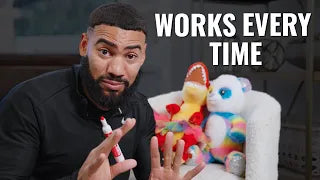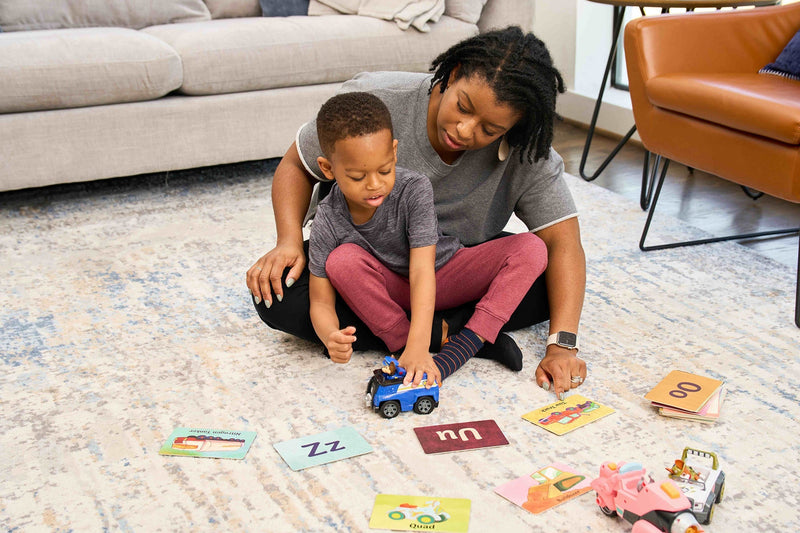It’s not every day a former-teacher-turned-online “influencer” is invited to keynote at SXSW EDU. So when I got the opportunity, I took it. And I ran with it.
In front of a ballroom of professional educators, I talked about:
- my biggest teaching mistakes
- why I started Toddlers Can Read
- my frustration that we educators appear to be obsessed with researching teaching reading instead of, you know, teaching reading
You can watch the whole keynote here, if you’d like.
If you don’t have an hour today, I get it. But I hope you’ll read this post, at least, because I ended my talk by sharing five things educators can do to help more people learn to read.
And here’s how I’d apply those five things to parents.
#1 Vet what people say is best for your kid.
We know a lot about how our brains learn to read. According to neurologists, reading requires our brains to engage a visual system that connects the shapes of letters to their spoken sounds.
That means kids need to know what sounds the letters make (phonics) and know how to manipulate and blend those sounds together (phonemic awareness).
Despite all the science, though, people (including educators) are still arguing about how to teach kids to read. Some think children should start by memorizing and contextualizing sight words. Or they say kids aren’t capable of learning to read until they’re at least 6 years old—and that it’s developmentally inappropriate to teach them any sooner.
But none of that is true.
What is true, is all of our arguing about the “right” way to teach reading is getting us absolutely nowhere.
- Only 33% of 4th graders are NAEP Proficient
- 63% of 12th graders are not reading proficiently
- 52 million adults read below a 3rd-grade level
And these numbers are even worse for marginalized folks across the country.
Here’s the bottom line: Decades of research have shown us how reading actually works. We should use what we know instead of talking about what we know.
And as a parent, you can read the research and decide for yourself what’s best for your kid. Please, don’t take “experts say” at face-value. Vet what people are telling you.
#2 Don’t go overboard on your research.
Reading research and theory are important. But how we implement that research is what matters most. It’s called “best practices,” not “best information.”
So don’t get caught up in researching the best reading method, the best app, the best course, the best… whatever. Do a little research (like what you’re doing right now!) and start teaching.
#3 Go one step at a time.
Plenty of parents don’t try to teach their kids to read because reading education feels too complex.
But here’s the great news: There’s a simple, easy, effective way to teach reading one step at a time.
Let’s think about basketball. To play, you need to master several individual skills. Dribbling–just one of those foundational skills–requires 10 more skills, like gross motor coordination, strength, aim, and more. But coaches don’t teach all these skills together.
Reading works the same way. Just because great reading takes so many different skills doesn’t mean you have to teach all those skills at the same time.
In fact, slowing down and keeping things simple is entirely evidence-based. In 2022, the National Reading Panel released a report that confirmed kids learn to read best when they’re only taught one or two reading skills at a time.
And those skills have to be foundationally focused first. You can’t segment and spell without blending. You can’t blend letter sounds without first knowing the letter sounds.
We can teach reading simply and well by focusing on phonics instruction. Slow down and build skills over time. You’ll be amazed at the results!
#4 Partner with your kids’ teachers.
Educators and parents should always be on the same team, because they bring different benefits to the table. Teachers often have the skills but not the time for 1:1 instruction. Parents often have the time, but not the skills. And learning in the classroom and learning at home are fundamentally different.
When teachers and parents work together, kids have the supportive network they need to master early reading. It makes early reading education more effective, engaging, and enjoyable for everyone.
A special note for any teachers reading this: Parents are an essential part of the educational team. Our students are borrowed, our roles are temporary, and our knowledge is transferable. By partnering with families, we can be a part of breaking generational cycles and creating literacy-fueled communities.
And a special note for parents: If your child loves to learn but not from you, I have a resource that will help. Read this to get my go-to tips and tricks to beat learning-time pushback.
#5 Get started now!
It’s never too early or late. Even if your child is 18-months old. Even if your child has a learning disability. Even if you struggle to read.
And the best way to prevent negative outcomes is to start evidence-based literacy education today.
You can teach your kid to read.
By prioritizing research-backed, collaboratively focused, and simple teaching strategies, you can teach your child (or anyone!) to read.
I walk you through the whole process, one step at a time, in my Ready-to-Read 3 Course Bundle.
Find out how you can teach your child to read, using effective and engaging activities you can do in just 5-10 minutes/day (no teaching experience required).






